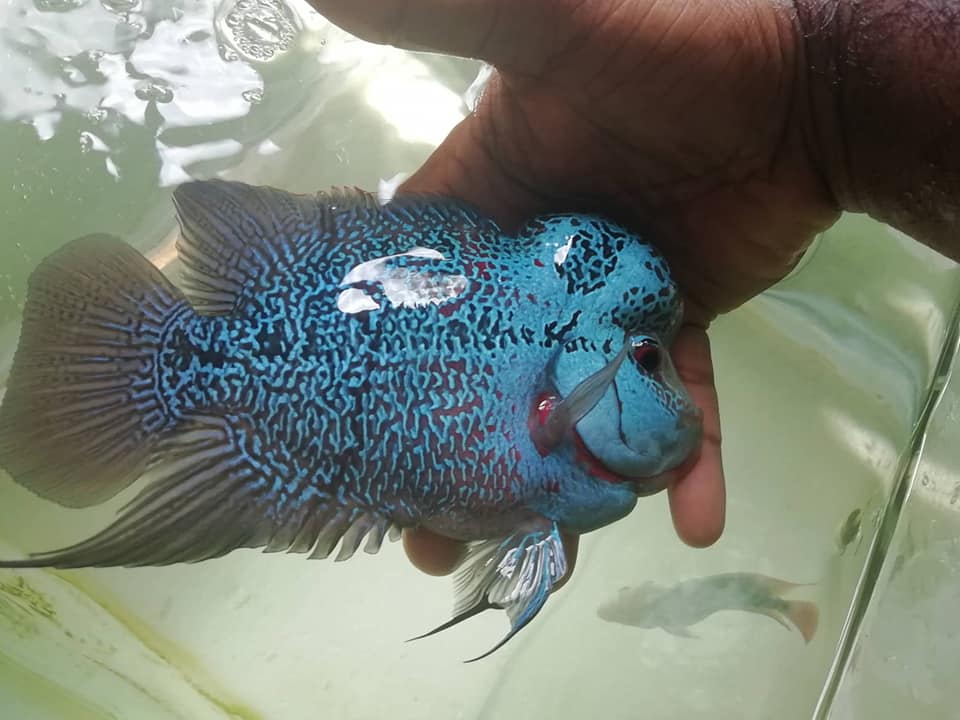- Your cart is empty
- Continue Shopping
Comprehensive Guide to Flowerhorn Fish Diseases

As Flowerhorn fish keepers, we always strive to provide the best care for our aquatic pets. However, despite our best efforts, Flowerhorn fish can still fall prey to various diseases that can compromise their health and well-being. In this comprehensive guide, we will discuss the most common diseases that affect Flowerhorn fish, their symptoms, causes, and treatments, as well as some preventive measures to minimize the risk of infections.
1. Hole-in-the-Head Disease
One of the most notorious diseases that affect Flowerhorn fish is Hole-in-the-Head disease. As the name implies, this disease manifests as small holes in the fish's head area, which can eventually develop into larger craters if left untreated. The disease is caused by a parasite called Hexamita, which thrives in poor water conditions, high stress levels, and poor nutrition. Symptoms of Hole-in-the-Head disease include loss of appetite, lethargy, and discolored feces. To treat this disease, we recommend improving water quality by performing frequent water changes, using a high-quality filter, and feeding the fish a balanced and nutritious diet. You can also use medication such as Metronidazole to kill the parasite.
2. Swim Bladder Disorder
Another common ailment that affects Flowerhorn fish is Swim Bladder Disorder. This condition affects the fish's ability to swim properly and maintain its balance in the water. Symptoms of Swim Bladder Disorder include a tilted or upside-down fish, difficulty swimming, and loss of appetite. Swim Bladder Disorder can be caused by various factors such as bacterial infections, constipation, and genetic predisposition. To treat this disease, we recommend adjusting the fish's diet to include more fiber-rich foods such as peas, avoiding overfeeding, and adding aquarium salt to the water. You can also use antibiotics such as kanamycin to treat bacterial infections.
3. Dropsy
Dropsy is a severe disease that affects the fish's internal organs, causing fluid buildup and swelling in the body. Dropsy is often a sign of an underlying condition such as bacterial infection, poor water quality, or kidney failure. Symptoms of Dropsy include bloating, pinecone-like scales, and lethargy. To treat this disease, we recommend improving water quality by performing frequent water changes, adding aquarium salt to the water, and using medication such as Furan-2 or Erythromycin to treat bacterial infections.
4. Ich
Ich or white spot disease is a common disease that affects various freshwater fish, including Flowerhorn fish. This disease is caused by a parasite called Ichthyophthirius multifiliis, which manifests as white spots on the fish's body and fins. Symptoms of Ich include scratching against objects, lethargy, and loss of appetite. To treat this disease, we recommend raising the water temperature to 86°F (30°C) for several days, adding aquarium salt to the water, and using medication such as Copper Sulfate or Malachite Green to kill the parasite.
5. Velvet Disease
Velvet disease is another parasitic disease that affects Flowerhorn fish, causing a golden or rusty dust-like appearance on the fish's skin and fins. Velvet disease is caused by the parasite Piscinoodinium pillulare, which thrives in poor water conditions, high stress levels, and poor nutrition. Symptoms of Velvet disease include loss of appetite, lethargy, and labored breathing. To treat this disease, we recommend improving water quality by performing frequent water changes, using a high-quality filter, and feeding the fish a balanced and nutritious diet. You can also use medication such as Copper Sulfate or Formalin
Preventive Measures
Prevention is always better than cure when it comes to Flowerhorn fish diseases. Here are some preventive measures that you can take to minimize the risk of infections:
- Maintain good water quality by performing regular water changes, using a high-quality filter, and testing the water parameters regularly.
- Avoid overfeeding your fish and feeding them a balanced and nutritious diet.
- Quarantine new fish for at least two weeks before introducing them to the main tank to prevent the spread of diseases.
- Avoid overcrowding the tank and provide enough space and hiding places for the fish to reduce stress levels.
- Monitor your fish's behavior and appearance regularly and seek veterinary advice if you notice any signs of illness.
Conclusion
In conclusion, Flowerhorn fish are beautiful and fascinating pets, but they are not immune to diseases. As responsible keepers, we need to be vigilant and proactive in providing our fish with the best possible care and treatment in case they fall sick. By following the preventive measures and treatment guidelines discussed in this guide, you can help your Flowerhorn fish live a healthy and happy life. Remember, a little care and attention can go a long way in ensuring the well-being of your aquatic pets.

